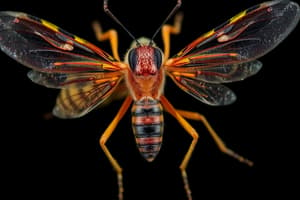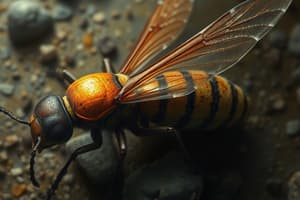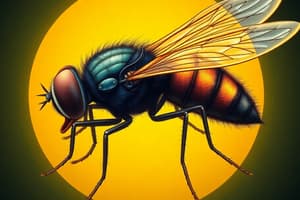Podcast
Questions and Answers
What allows bees and butterflies to perceive 'true color'?
What allows bees and butterflies to perceive 'true color'?
- Trichromatic color vision (correct)
- Infrared vision
- Bioluminescence
- Monochromatic vision
What unique vision adaptation do dragonflies possess?
What unique vision adaptation do dragonflies possess?
- Sensing motion with only peripheral vision
- Night vision using thermal imaging
- Low-resolution but color-sensitive eyes
- High-resolution vision with divided eye sections (correct)
What is the primary function of pheromones in insects?
What is the primary function of pheromones in insects?
- To detect and respond to environmental hazards
- To communicate and regulate behaviors within the same species (correct)
- To help insects digest food
- To aid in the navigation of migratory paths
How do nocturnal insects like moths differ in vision from diurnal insects?
How do nocturnal insects like moths differ in vision from diurnal insects?
What is the instinctive movement of insects toward light sources called?
What is the instinctive movement of insects toward light sources called?
What helps dung beetles navigate at night?
What helps dung beetles navigate at night?
Where are gustatory receptors primarily located in insects?
Where are gustatory receptors primarily located in insects?
What distinguishes volatile from non-volatile pheromones?
What distinguishes volatile from non-volatile pheromones?
What impact does elevated CO2 have on the fitness of female cochineal insects?
What impact does elevated CO2 have on the fitness of female cochineal insects?
What is the effect of elevated CO2 on the damage caused by cochineal insects to Opuntia stricta?
What is the effect of elevated CO2 on the damage caused by cochineal insects to Opuntia stricta?
Which factors influence the development rate of blow-flies?
Which factors influence the development rate of blow-flies?
How does elevated CO2 influence the mortality rate of Opuntia stricta?
How does elevated CO2 influence the mortality rate of Opuntia stricta?
What challenge does rising atmospheric CO2 levels pose regarding biocontrol efforts?
What challenge does rising atmospheric CO2 levels pose regarding biocontrol efforts?
What is one additional benefit of forensic entomology?
What is one additional benefit of forensic entomology?
What role do ommatidia play in insect vision?
What role do ommatidia play in insect vision?
What further research is suggested regarding elevated CO2 and invasive weeds?
What further research is suggested regarding elevated CO2 and invasive weeds?
What type of vision do most insects possess?
What type of vision do most insects possess?
When did insect vision first emerge?
When did insect vision first emerge?
Which structure in an insect's eye is responsible for absorbing and channeling light?
Which structure in an insect's eye is responsible for absorbing and channeling light?
What advantage does trichromatic color vision provide certain insects?
What advantage does trichromatic color vision provide certain insects?
What is maggot therapy primarily used for?
What is maggot therapy primarily used for?
What factors can lead to host-plant incompatibility in biological control?
What factors can lead to host-plant incompatibility in biological control?
How does elevated CO2 impact the effectiveness of biocontrol agents on invasive weeds?
How does elevated CO2 impact the effectiveness of biocontrol agents on invasive weeds?
What is a potential consequence of misidentification of biocontrol agents?
What is a potential consequence of misidentification of biocontrol agents?
Why is accurate taxonomic identification crucial in biological control programs?
Why is accurate taxonomic identification crucial in biological control programs?
What is an ongoing area of research related to biological control effectiveness?
What is an ongoing area of research related to biological control effectiveness?
What specific increase in plant biomass is observed under elevated CO2 conditions (600 ppm)?
What specific increase in plant biomass is observed under elevated CO2 conditions (600 ppm)?
Which of the following plant defenses is enhanced under elevated CO2 levels?
Which of the following plant defenses is enhanced under elevated CO2 levels?
What adverse effect can elevated CO2 levels have on the nutritional quality of invasive weeds for biocontrol agents?
What adverse effect can elevated CO2 levels have on the nutritional quality of invasive weeds for biocontrol agents?
What does the 'Structural Effect' in plants lead to as a response to elevated CO2?
What does the 'Structural Effect' in plants lead to as a response to elevated CO2?
What is a key characteristic of the 'Metabolite Effect' in plants due to elevated CO2?
What is a key characteristic of the 'Metabolite Effect' in plants due to elevated CO2?
Which behavioral adaptation may insects use to cope with increased CO2 levels?
Which behavioral adaptation may insects use to cope with increased CO2 levels?
What physiological changes might insects undergo in response to elevated CO2?
What physiological changes might insects undergo in response to elevated CO2?
How do leaf chewers typically respond to elevated CO2 levels?
How do leaf chewers typically respond to elevated CO2 levels?
What is the general response of phloem feeders, like aphids, to elevated CO2?
What is the general response of phloem feeders, like aphids, to elevated CO2?
What is the impact of elevated CO2 on leaf miners, root feeders, and gallers?
What is the impact of elevated CO2 on leaf miners, root feeders, and gallers?
What classification describes insects regarding their thermoregulation?
What classification describes insects regarding their thermoregulation?
Flashcards are hidden until you start studying
Study Notes
Blow Flies and Forensic Entomology
- Blow flies are the first insects found on corpses, and their development stages help determine the post-mortem interval (PMI).
- Factors influencing blow fly development include species, temperature, weather, and body position.
- Forensic entomology helps determine if a body has been moved, identifies trauma based on maggot distribution, and detects drugs or toxins in flies or maggots (Entomotoxicology).
- Maggot therapy, utilizing sterilized blow-flies, particularly greenbottles (Lucilia spp.), helps remove damaged tissue, regenerate cells, and reduce infections.
Insect Vision
- Insect vision originated during the Cambrian explosion period, around 540 million years ago.
- Ommatidia are the functional units of vision in compound eyes, acting as pixels in a digital image.
- Dragonflies have about 30,000 ommatidia, granting them exceptional vision with high resolution.
- Compound eyes produce a 'mosaic' image.
- The protocerebrum, deutocerebrum, and tritocerebrum are the three main brain parts that process visual information in insects.
- Light travels through the cornea and cone to reach the photoreceptors.
- The rhabdom absorbs and channels light.
- Retinula cells are the photoreceptor cells that detect light and convert it into electrical signals.
- Most insects have dichromatic color vision, meaning they have two color pigments and cannot distinguish every color.
- Bees and butterflies have trichromatic color vision, allowing them to see 'true color'.
- Many insects, like bees, can detect ultraviolet (UV) light, aiding them in finding nectar guides on flowers.
- Dragonflies have high-resolution vision and eyes divided into dorsal and ventral sections to detect prey and predators.
- Nocturnal insects, like moths, have low-resolution vision but high light sensitivity.
- Dung beetles navigate using starlight, marking them as the first insects known to do so.
- Positive phototaxis is an instinctual movement towards light sources, attracting insects.
Insect Olfaction, Gustation, and Communication
- Insect olfaction involves the detection of chemicals influencing their physiology and behavior.
- Insects primarily use their antennae for olfaction, containing specialized structures called sensilla that house olfactory receptor neurons (ORNs).
- Gustatory receptors, found on insect legs and mouthparts, are used for taste.
- Pheromones are scent signals released by insects to communicate with others of the same species for mating, alarm signals, trail marking, and aggregation.
- Volatile pheromones travel through the air and are detected over long distances, while non-volatile pheromones are detected through contact.
Insect Defenses and Plant Responses to Elevated CO2
- Insects have developed various physical and chemical defenses to deter predators.
- The "Structural Effect" in plants with elevated CO2 results in tougher structures, increasing feeding and foraging time for insects.
- The "Metabolite Effect" due to elevated CO2 involves plants producing more defensive metabolites, making them less palatable and disrupting insect digestion.
- Insects exhibit behavioral responses to cope with elevated CO2, including selective feeding, timing of feeding, and compensatory feeding.
- Physiological adaptations in insects include nutrient conversion, metabolic changes, increased midgut length and size for nutrient absorption, and increased foregut size for processing tougher plant material.
- Leaf chewers generally experience increased compensatory feeding but decreased development, size, and fecundity.
- Phloem feeders show mixed responses: some species, like aphids, benefit from increased sugar availability.
- Leaf miners, root feeders, and gallers typically experience negative impacts on development, survival, size, and fecundity due to nutrient dilution.
- Elevated CO2 indirectly impacts insects by altering plant quality, leading to slower growth, prolonged development, decreased metabolism, and reduced fecundity in phytophagous insects.
- Insects are classified as ectotherms (poikilotherms), meaning their body temperature is largely determined by ambient temperature.
- Temperature significantly impacts survival, growth, digestion, metabolism, reproduction, and distribution in insects.
Biological Control and Elevated CO2
- Elevated CO2 levels enhance the biomass and defenses of invasive weeds, reducing the effectiveness of biocontrol agents.
- Elevated CO2 increases CO2 uptake in plants with less water loss, improving water use efficiency.
- Plants under elevated CO2 conditions show increased biomass, water use efficiency, and changes in physical characteristics.
- Elevated CO2 can alter the nutritional quality of invasive weeds, making them less desirable for biocontrol agents.
- Elevated CO2 can negatively impact the fitness of biocontrol agents.
- Elevated CO2 can reduce the effectiveness of biocontrol agents by decreasing their ability to damage target weeds.
- Elevated CO2 does not appear to affect the mortality rate of invasive weeds.
- Rising atmospheric CO2 levels pose a challenge to biocontrol efforts, necessitating further research on the combined effects of elevated CO2 and temperature on the interactions between invasive weeds and biocontrol agents.
- Host-plant incompatibility can occur due to genetic variation in weeds, leading to ineffective control.
- Accurate taxonomic identification of biocontrol agents is crucial for effective control, avoiding unintended consequences for non-target species.
- Misidentification of biocontrol agents results in ineffective control, unintended consequences for non-target species, and the failure of the biocontrol initiative.
- The impact of rising CO2 levels and climate change on biological control effectiveness remains an active area of research.
Studying That Suits You
Use AI to generate personalized quizzes and flashcards to suit your learning preferences.




